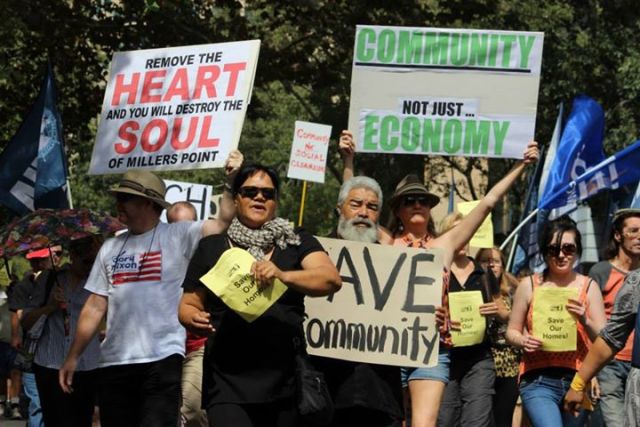
Community Services Minister Pru Goward announced that 293 public housing in Millers Point and The Rocks on Sydney's harbourside would be sold. The billions gained would be used to invest in public housing in the rest of the state, Goward said. But the sell-off would come at a human cost — the destruction of the close-knit working-class community that has existed there for hundreds of years.
Barney Gardner is a well-known community leader and a member of Millers Point Save Our Homes. The 65-year-old has lived in Millers Point all his life. For him and many others, the government's announcement is a tragedy.
Millers Point has a long history of hosting Sydney's poor workers. Gardner told Green Left Weekly: “People say Australia was born on a sheep's back. That may be true, but all that wool had to go somewhere, and it came here to be exported.”
The area originally housed mainly maritime workers who worked on the nearby wharves. The rents were cheap because of the nature of the area. In fact, up until only a few decades ago, the wealthier denizens of Sydney looked down on the area.
“The roads were our playgrounds, we swam down in the harbour, we would go fishing because you could do it for free down on the wharves,” Gardner said.
But the area has changed markedly. “I've seen a lot of the old woolstores turned into offices, and a lot of the offices turned into apartments. This wasn’t done for the benefit for the public housing tenants, but we still got along with all these people. We have no jealousy or animosity towards them.”
Indeed, Gardner told GLW that many new private residents love the simple fact that people say hello to each other in the streets, a rarity in the rest of the bustling metropolis.
The community’s spirit remains high, but public housing conditions have deteriorated. "They didn’t continue doing the regular repairs that the maritime board did, who previously managed our housing. Houses began to fall into disrepair, some of the places are shocking. But we do the best we can, we all help each other out. I personally have helped paint two houses.”
The residents see a long-term trend of the department seems to deliberately run down the public housing tenancy. "I've been told now that since 2009, no families were being moved into this area. They were moving single elderly people in, they were moving vulnerable people in. It was a form of attack on us, the public housing tenants, because the government knows they can move them on at any time. The thorn in their side is us long-termers ... but we've adopted a lot of these vulnerable people into our community too.
“They move a lot of people with social problems here, more than we can handle. Mind you we look after our neighbours if they've got a problem, but we can't look after them all. They just fall through the cracks in the system.
“They're gonna socially cleanse this area ... it’s the total destruction of a community that has existed for near on 200 years.”
Even if the sell-off takes place, Gardner is wary of what will come of the money. The government has previously made $42 million by selling 30 houses in the area, which was meant to be reinvested in the area. “When we questioned them they said, no it’s going to Glebe. We asked people in Glebe were there any major projects in the area, they said no. Where has the money gone? Are we to trust them to put billions of dollars back into public housing? I think not.”
The media have spread many misconceptions about Millers Point public housing. One is the low rent they pay. People in public housing are the most vulnerable in society, and the waiting list is about 50,000 in NSW. It is reasonable to expect that most people in housing are on welfare. “Everyone knows when you pay rent to department of housing when you're on welfare, you pay 25% and that’s a minimum of at least $100. Low income earners pay 30%, Gardner said. “And it goes up the scale until you pay market rates.”
"My dad worked on the wharves, my mum worked in the canteen on the wharves. We've contributed to this community for years. I know people who go back four or five generations. We haven’t been sitting on our bums on welfare all the time, we built this community. I wish people would appreciate that instead of saying we're all welfare bludgers."
Gardner was an electrician then a dockworker until both his hips needed replacement, forcing him onto the disability pension. His partner Glenda “lost a few jobs in the Rocks that have closed down. She still goes to jobsearch, but she's 64. So where does she place on the system?"
Another myth is their million-dollar views. Gardner said: "In front of me were double decker finger wharves. No view. That was stripped down to make container sheds, no view. That was pulled down and it was the first time we had a view. But that’s soon to be lost because they're going to develop Barangaroo." Other properties, he said, have “good” views of old woolstores, apartment buildings and concrete walls.
Another misconception is the millions in subsidies that Goward says tenants in Millers Point receive. But as the NSW Tenants Union says, this is just the perceived missed revenue for not charging tenants market rates.
In other words, tenants are not receiving millions in cash from the government. Instead they are paying the department rents, and receiving barely any maintenance in return — and the possible destruction of their communities.
"It's just a total grab for money at the expense of some of the most vulnerable people of our society. The people own these properties, the people should have a say about whether we should stay or go.”